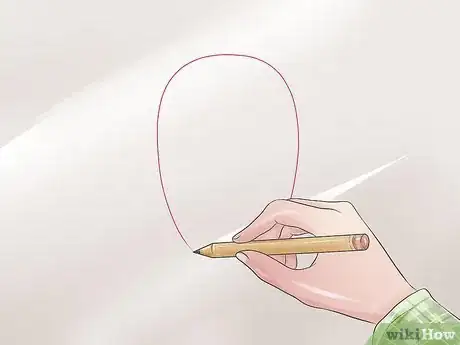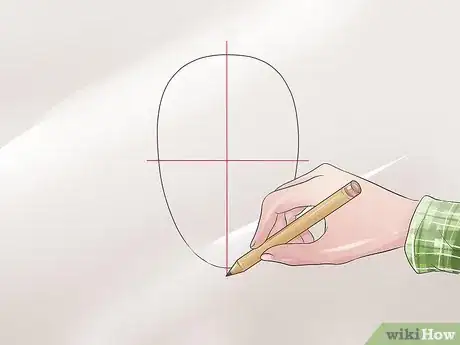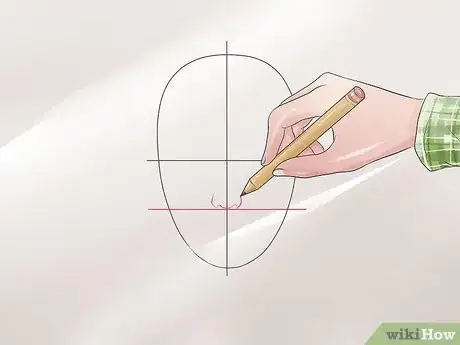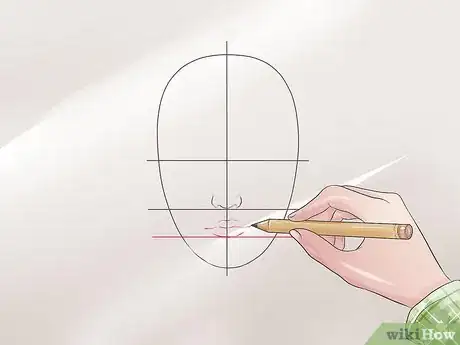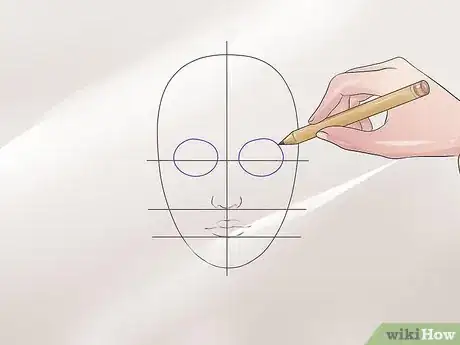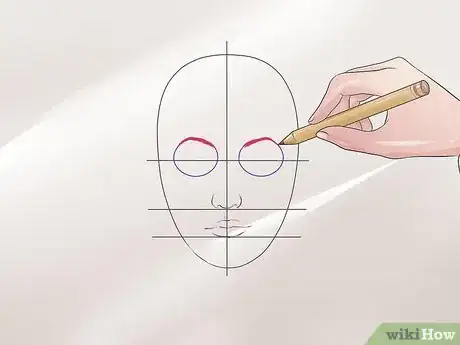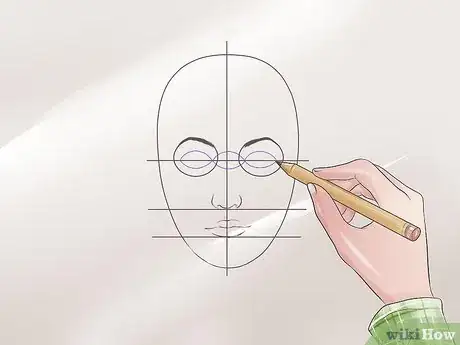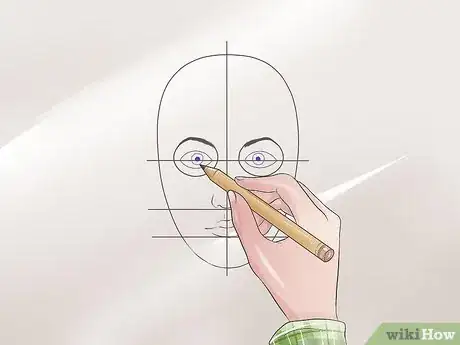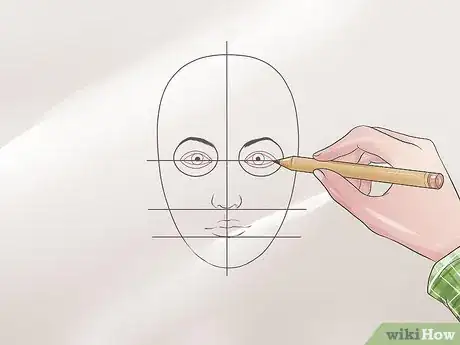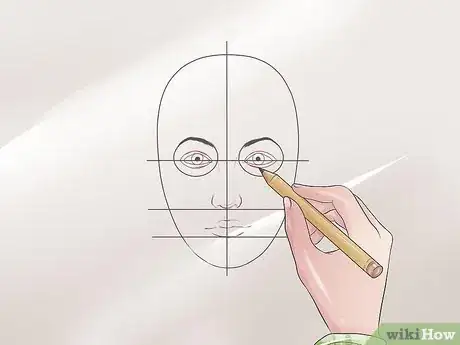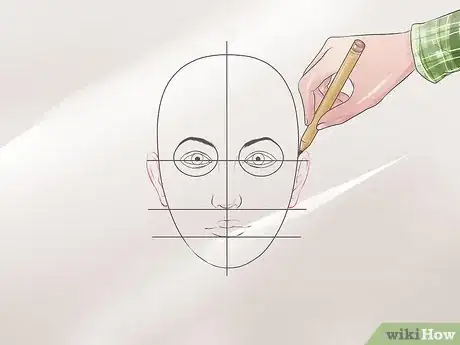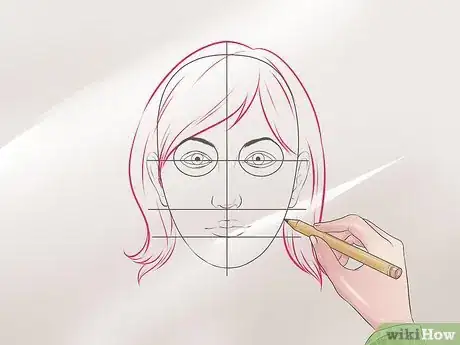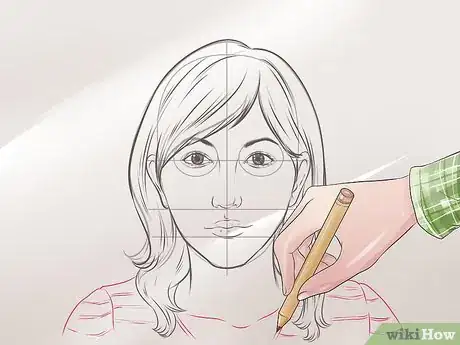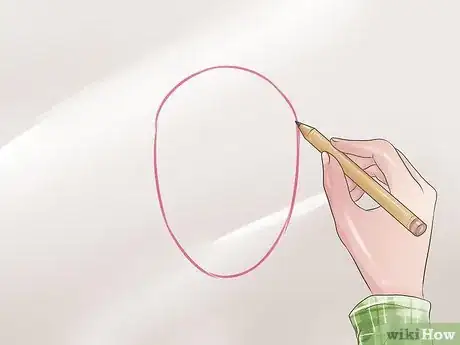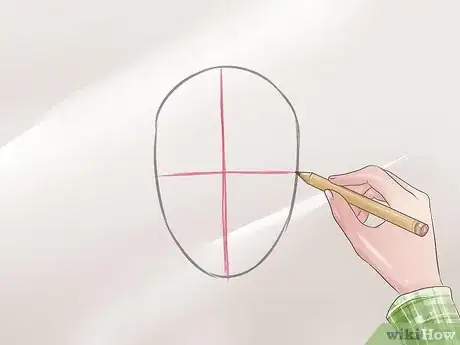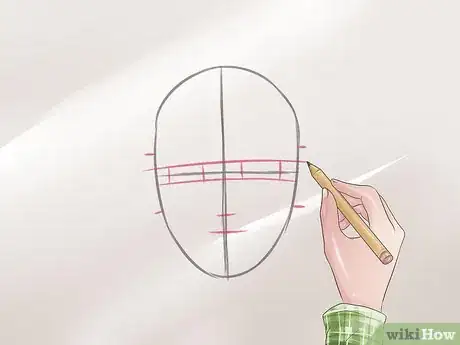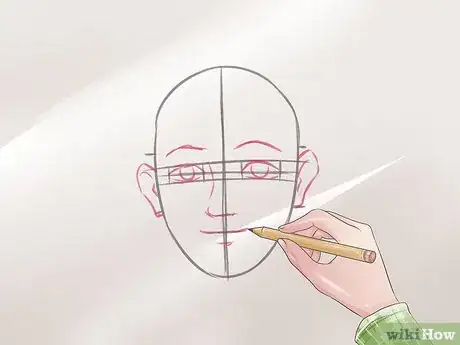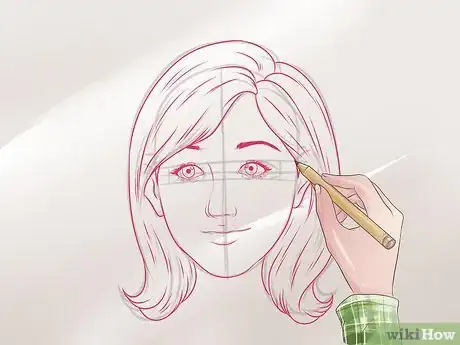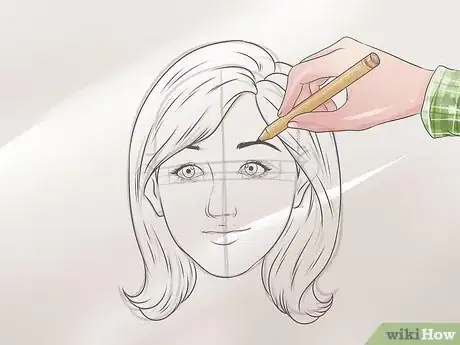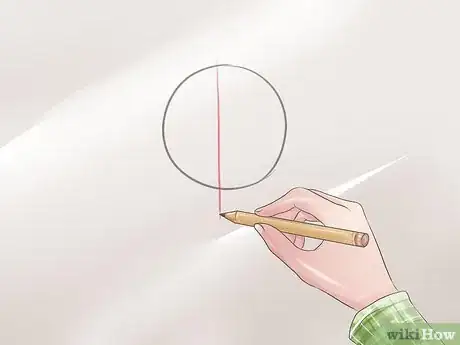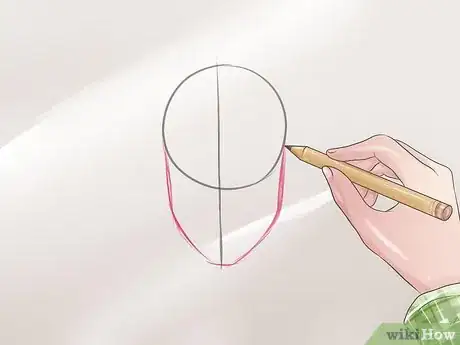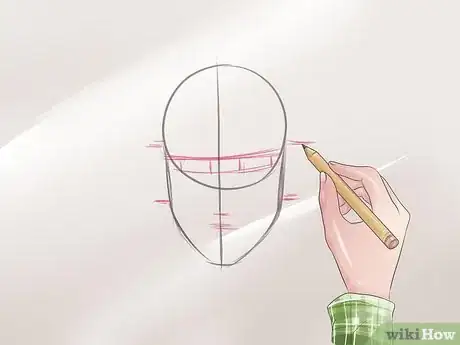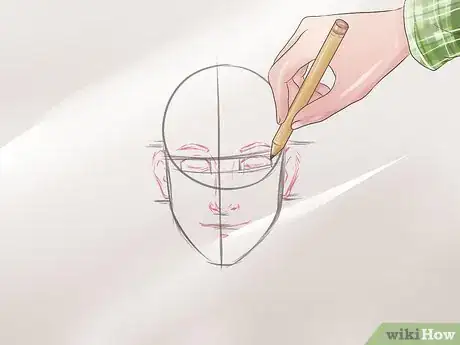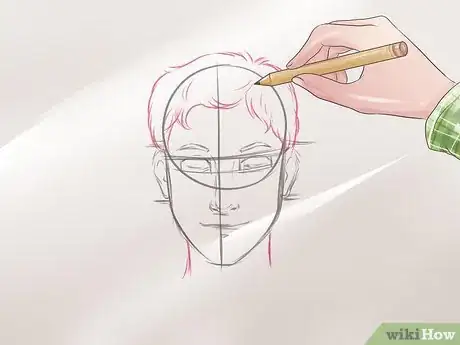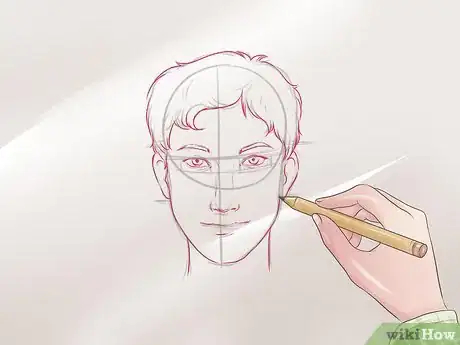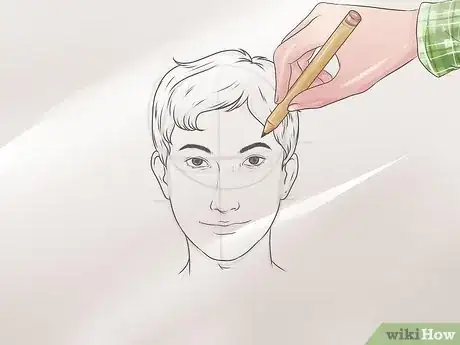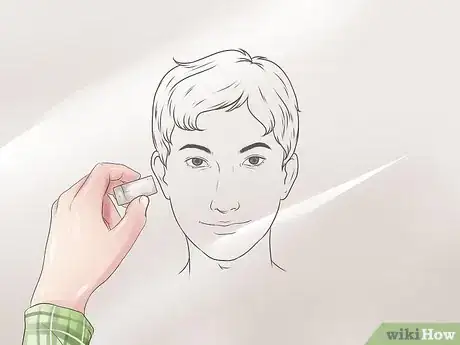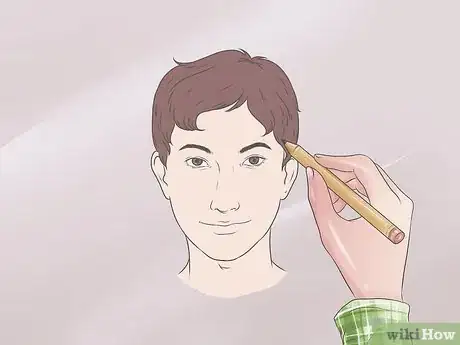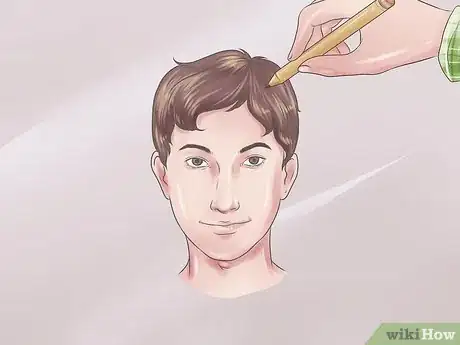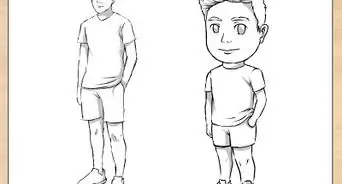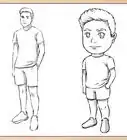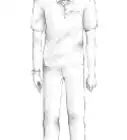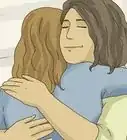wikiHow is a “wiki,” similar to Wikipedia, which means that many of our articles are co-written by multiple authors. To create this article, 175 people, some anonymous, worked to edit and improve it over time.
This article has been viewed 3,061,874 times.
Learn more...
Faces are the basic part of the human anatomy, and can display a wide variety of emotions. In a portrait or artwork of people, faces would be the main focal point, so each stroke has a significant effect on what mood is portrayed. Drawing a face correctly is a huge step towards becoming a great artist. In this article, you will see the technique for drawing particular face-shapes.
Steps
Adult Female Face
-
1Make a light outline of a face. Heads are never circular, they are oval shaped, like an egg. So sketch an oval outline that tapers down at the bottom.[1]
-
2Add dividing lines. The easiest way to start is to use dividing lines to map out the proportions of the face. Firstly, draw a line down the center of the oval. Then cut the oval in half again, this time horizontally.[2]Advertisement
-
3Add the nose. Divide the lower half again with another horizontal line. The point at which this crosses the vertical line is where you should begin to draw the base of the nose. Sketch out the base of the nose and a nostril either side.[3]
-
4Add the mouth. Divide the bottom quarter in half again. The bottom of the lips will rest on the dividing line you have just drawn. Draw a line for where the lips meet and then draw the top lip. Now fill in the bottom of the lip.[4]
-
5Add the eyes.[5]
- Draw two big circular balls to make out the eyes across the central horizontal line. These will form the eye sockets. The top of this circle is where the eyebrow is and at the bottom is where the cheekbone sits.
- Draw the eyebrows along the top.
- You then need to work on the shape of the eyes. Eyes are almond shaped, so bear this in mind as you sketch them (eyes come in every size and shape, so feel it out). As a rule of thumb, the distance between the two eyes is the width of another eye.
- Inside the iris, the color inside the center of the eye, draw the pupil, which is the darkest bit of the eye. Fill most of it in black and leave a little white. With your pencil flat, use a bit of shading for the base. Shade variant from medium and light in the iris, using tightly spaced short lines from the edge of the pupil to the white of the eye. Draw lighter in some areas to give it a nice effect. Draw eyebrows above. Now rub out the guidelines below the eye.
- Next, draw the top of the eyelid over the top of the almond. The base of the eyelid comes down over the top of the iris and covers the top of it slightly.
-
6Shading under the eyes. Now, add a little shading underneath the eye and where the eye meets the nose to define the socket. For a tired look, add shading and swooped lines at a more acute angle to the bottom eyelid.
-
7Add the ears. The base of the ear should be drawn in line with the bottom of the nose and the top of the ear in line with the eyebrows. Remember, ears should be flat against the side of the head.[6]
-
8Add the hair. Make sure that you draw the hair from the parting outwards.[7]
-
9Draw the neck. Necks are thicker than you imagine. Draw two lines coming down from roughly where the bottom horizontal line meets the edges of the face.
-
10Add the details. Add a bit of shading under the nose and accentuate the chin. Put expression lines around the mouth, and shading in the corners. Then outline the ridge of the nose. The more prominent you make these features, the "older" your face will look.[8]
-
11You may want to draw clothes using a style such as cross hatching.
-
12Clean. Use an eraser to remove any guidelines.
Youth Female Face
-
1Draw the shape of the head you have in mind.
-
2Add lines to determine the center of the face and the position of the eyes.[9]
-
3Sketch lines to define how wide, tall, and the placement of the eyes, nose, mouth and ears.
-
4Sketch the shape and appearance of the eyes, nose, mouth, ears, and eyebrows.[10]
-
5Sketch the shape of the hair and neck.
-
6Use a smaller tipped drawing tool to add the finer details of the face.
-
7Draw the outline using the sketch as a guide.
-
8Erase and remove the sketch marks to produce a clean outlined drawing.
-
9Add color and shading to the drawing.
Male Face
-
1Drawing lightly, sketch a circle.
-
2Draw a line at the middle starting from the top and ending where the chin would be.https://www.easydrawingtips.com/how-to-draw-male-face-step-by-step-tutorial/ (This line determines that the face is facing towards you).
-
3Sketch lines to define the shape of the cheeks, jaw and chin.
-
4Sketch lines to define how wide, tall, and the placement of the eyes, nose, mouth and ears.[11]
-
5Sketch the shape and appearance of the eyes, nose, mouth, ears, and eyebrows.[12]
-
6Sketch the shape of the hair and neck.[13]
-
7Use a smaller tipped drawing tool to add the finer details of the face.
-
8Draw the outline using the sketch as a guide.
-
9Erase and remove the sketch marks to produce a clean outlined drawing.
-
10Add color to the drawing.
-
11Optional: add shading to the drawing if needed.
Community Q&A
-
QuestionWhat are some tricks to make my drawings look more realistic?
 Renée PlevyRenée Plevy is an Internationally Acclaimed Portrait Artist from New York/Palm Beach who has painted The Grand Dames of Palm Beach and various celebrities and community leaders. With over 50 years of experience, Renée specializes in painting realistically in oil and capturing the soul of the person. She has studied under internationally renowned portrait artists John Howard Sanden, David Leffel, Robert Beverly Hale, Clyde Smith, and Leonid Gervits. Renée is featured in over 68 shows and galleries including a one-woman museum show at the Paterson Museum. She has garnered numerous awards including “Artist of the Year” from The Bloomfield Art League and First Prize from the Boca Raton Museum Artist’s Guild. Renée has even painted a portrait of celebrity, Vanilla Ice. She also teaches at the Boca Raton Museum Art School - formerly at SVA in Manhattan.
Renée PlevyRenée Plevy is an Internationally Acclaimed Portrait Artist from New York/Palm Beach who has painted The Grand Dames of Palm Beach and various celebrities and community leaders. With over 50 years of experience, Renée specializes in painting realistically in oil and capturing the soul of the person. She has studied under internationally renowned portrait artists John Howard Sanden, David Leffel, Robert Beverly Hale, Clyde Smith, and Leonid Gervits. Renée is featured in over 68 shows and galleries including a one-woman museum show at the Paterson Museum. She has garnered numerous awards including “Artist of the Year” from The Bloomfield Art League and First Prize from the Boca Raton Museum Artist’s Guild. Renée has even painted a portrait of celebrity, Vanilla Ice. She also teaches at the Boca Raton Museum Art School - formerly at SVA in Manhattan.
Portrait Artist & Educator When a person starts to do a portrait or a drawing of a face, they tend to put the person in a very unrealistic position. Instead of putting the person at eye level, looking directly at you, try a variation of that pose. Draw the person as if they have bent their head down, or moved it to the right or the left, or tilted it.
When a person starts to do a portrait or a drawing of a face, they tend to put the person in a very unrealistic position. Instead of putting the person at eye level, looking directly at you, try a variation of that pose. Draw the person as if they have bent their head down, or moved it to the right or the left, or tilted it. -
QuestionHow can I get better at drawing faces?
 Renée PlevyRenée Plevy is an Internationally Acclaimed Portrait Artist from New York/Palm Beach who has painted The Grand Dames of Palm Beach and various celebrities and community leaders. With over 50 years of experience, Renée specializes in painting realistically in oil and capturing the soul of the person. She has studied under internationally renowned portrait artists John Howard Sanden, David Leffel, Robert Beverly Hale, Clyde Smith, and Leonid Gervits. Renée is featured in over 68 shows and galleries including a one-woman museum show at the Paterson Museum. She has garnered numerous awards including “Artist of the Year” from The Bloomfield Art League and First Prize from the Boca Raton Museum Artist’s Guild. Renée has even painted a portrait of celebrity, Vanilla Ice. She also teaches at the Boca Raton Museum Art School - formerly at SVA in Manhattan.
Renée PlevyRenée Plevy is an Internationally Acclaimed Portrait Artist from New York/Palm Beach who has painted The Grand Dames of Palm Beach and various celebrities and community leaders. With over 50 years of experience, Renée specializes in painting realistically in oil and capturing the soul of the person. She has studied under internationally renowned portrait artists John Howard Sanden, David Leffel, Robert Beverly Hale, Clyde Smith, and Leonid Gervits. Renée is featured in over 68 shows and galleries including a one-woman museum show at the Paterson Museum. She has garnered numerous awards including “Artist of the Year” from The Bloomfield Art League and First Prize from the Boca Raton Museum Artist’s Guild. Renée has even painted a portrait of celebrity, Vanilla Ice. She also teaches at the Boca Raton Museum Art School - formerly at SVA in Manhattan.
Portrait Artist & Educator You need to do a lot of reading, you need to do sketching, but primarily, you need to find a good teacher in your area who will help you to see what you're missing. We have a tendency not to actually see what's in front of us, and that's tough when you have to develop an artist's eye.
You need to do a lot of reading, you need to do sketching, but primarily, you need to find a good teacher in your area who will help you to see what you're missing. We have a tendency not to actually see what's in front of us, and that's tough when you have to develop an artist's eye. -
QuestionDo the lines have to be strong?
 Community AnswerSome lines should be stronger than others, like the locks of hair or the silhouette of the face. But always start with light lines so, if you make a mistake, you can erase it easily without too much trouble. When you are finished, you should outline it in pencil along with any other lines you want to stand out, like the outline of the eyes and strands of hair and the pupils of the eyes and the mouth.
Community AnswerSome lines should be stronger than others, like the locks of hair or the silhouette of the face. But always start with light lines so, if you make a mistake, you can erase it easily without too much trouble. When you are finished, you should outline it in pencil along with any other lines you want to stand out, like the outline of the eyes and strands of hair and the pupils of the eyes and the mouth.
Things You'll Need
- Pencil
- Paper
- Ruler
- Eraser
- Pen (this is to trace back over the pencil lines)
References
- ↑ https://www.easydrawingtips.com/how-to-draw-female-face-step-by-step-tutorial/
- ↑ https://www.drawingforall.net/how-to-draw-a-female-face/
- ↑ https://www.easydrawingtips.com/how-to-draw-female-face-step-by-step-tutorial/
- ↑ https://www.easydrawingtips.com/how-to-draw-female-face-step-by-step-tutorial/
- ↑ https://www.drawingforall.net/how-to-draw-a-female-face/
- ↑ https://www.easydrawingtips.com/how-to-draw-female-face-step-by-step-tutorial/
- ↑ https://www.drawingforall.net/how-to-draw-a-female-face/
- ↑ https://www.drawingforall.net/how-to-draw-a-female-face/
- ↑ https://www.youtube.com/watch?v=yyfPULeQhPo
About This Article
When you’re drawing a face, begin by sketching in a basic oval shape. Most faces are rounded at the top and slightly narrower at the bottom, like an upside-down egg. Next, draw a line down the center of the face vertically, and another one horizontally halfway between the top and bottom. These lines will help you figure out how to position the features on the face. Draw another horizontal line halfway between the middle line and the bottom of the face, and sketch in the base of the nose so that it rests on that line. Use the vertical guideline to help you center the nose. Divide the lower part of the face in half again with another horizontal line, and draw the mouth so the bottom lip rests on top of the new guideline. Move back up to the first horizontal line and sketch in two circles on the line, positioning them on either side of the central vertical line. These shapes will form the eye sockets. Draw in the eyebrows at the tops of the circles, and use the bottoms to indicate where the tops of the cheekbones are. Sketch the eyes in the middle of each circle, using an almond shape. As a rule of thumb, try to leave about one eye’s width in the middle, between the eyes. Draw in the eyelids and add an iris and pupil to the center of each eye. Next, add the ears. The top of each ear should line up with the outer edges of the eyebrows, while the earlobe should line up with the bottom of the nose. Finish by filling in the hair, starting from the part and working your way out to the ends. You can also add the neck and shoulders if you like. When you’re done, erase the guidelines and add in details, like the eyelashes, shading under the eyes and nose, and natural-looking lines around the eyes and mouth. To vary the look of the face, practice changing the shapes and sizes of individual features. For example, keep in mind that adult male faces tend to have wider jaws and heavier brows than the faces of women and children. To learn how to add details to your drawing, keep reading!
